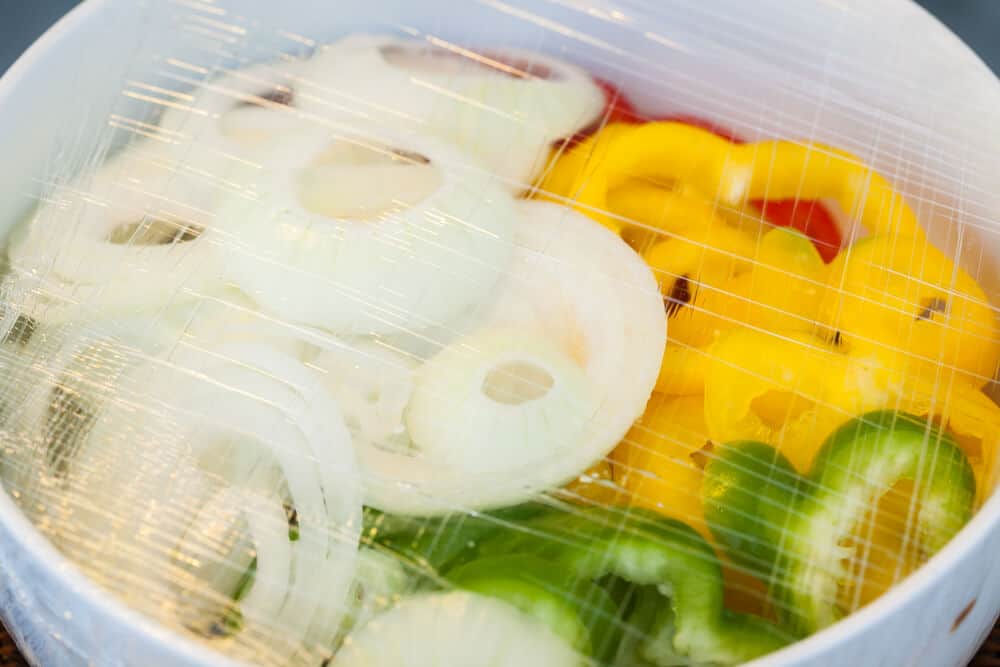We all have a habit of reaching for cling wrap, or other plastic products when we are preparing to heat something up in the microwave, especially if it is messy food.
It’s an understandable urge; no one wants chili or lasagna all over their microwave.
However, it’s essential to ask questions such as “Is cling wrap microwave safe?” or “Is it safe to use to heat my food?”.
The truth is, if you can avoid involving plastics in your food preparation, you definitely should. Some plastic cling wrap products advertise that they are microwave safe, while others do not tout this label.
However, neither of these products is really appropriate for food preparation if you are concerned about chemical leaching or other dietary toxin issues.
For more information on the differences between products that claim they are microwave safe and those that do not, keep reading!
We’ll also go over some plastic wrap alternatives that you can implement in your kitchen to avoid issues with cling wrap.
After all, it’s better to be safe than sorry when it comes to matters of your health.
What Is Cling Wrap?
Cling wrap is a widely used kitchen aid best described as a thin film of plastic intended to keep foods fresh for more extended periods of time.
There are plant-based plastics and non-plastic alternatives to cling wrap, which we will discuss further in.
Is Cling Wrap Microwave Safe?
These plastic films are fantastic for keeping food fresh while it is in cold storage; however, heating it up is not the best idea.
That said, however, some cling wrap products are safer than others.
Are Some Cling Wraps Safer To Microwave Than Others?
Some cling wraps are relatively safer than others to use in the microwave.
In general, if a plastic product advertises a “microwave safe” label, that doesn’t refer to the user’s safety, but it is still relevant information.
Instead, it refers to the product’s ability to withstand heat without warping, melting, or catching fire.
It is a common misconception amongst average shoppers that this safety label reassures them that the product will not leach any harmful chemicals such as BPA.
Unfortunately, the company is happy to allow this misconception to carry on because they are getting away with implying that it is safe for consumption without actually having to lie directly to make people believe it.
It is difficult for the FDA, EPA, and other organizations regulating the products and packaging we shop in-store or online to regulate such labels effectively.
While the statement “microwave safe” is true in the sense that it will not start a fire or cause your microwave to malfunction, it is not true in many others.
The regulation agencies can’t really do anything about the fact that what one party is saying is different from what the other party hears due to interpretation.
Why Do Some Cling Wraps Have Microwave Safe Labels ; Not Others?
You may be surprised to learn that language such as “microwave safe” does not actually mean that it is guaranteed to be safe for the consumer.
It actually means that it ensures that the plastic will not melt, warp, or catch fire, as mentioned above.
I grew up like many others, believing that the microwave-safe label meant that it was safe to place on food for microwaving purposes.
So, the cling wraps labeled for microwave safety won’t blow your microwave up if you place them inside.
On the other hand, cling wrap products that do not boast a microwave safety label are, in fact, dangerous to put in the microwave for any purpose, whether it is food-related or not.
Non-microwavable cling wraps are for cold storage and room temperature storage only.
If placed in the microwave, they can cause fire, microwave malfunction, harmful vapors, and melting.
These plastics are believed to be safe unless heated to extreme temperatures, however.
How Should Microwave Safe Cling Wrap Be Used?
Suppose you are determined to continue to use microwavable cling wrap plastic products in your kitchen.
In that case, there are a few tips we have for keeping your food as uncontaminated as possible.
First, make sure that there is an appropriate amount of moisture in the container that you are heating.
Secondly, you should check that the plastic film never actually has direct contact with your food.
If you aren’t sure how to make it work, use a deeper dish to keep food below the level that the plastic film will stretch across. Then, set your microwave to low or standard power.
Do not allow the microwave to run unsupervised. If steam or pressure builds up to the point that the plastic film breaks, it will contaminate your food by touching directly while superheated.
Check food regularly to ensure that the food or liquid is not superheating as well.
What Alternatives Can Be Used In Place Of Cling Wrap?
If you’re ready to ditch plastic cling wrap products altogether after learning more about it, that’s great!
There are many easy-to-implement, safe options for using as microwave mess guards or steam shields.
Some of our favorite options include items that are already in the kitchen, just waiting to be repurposed creatively.
For example, you can use your ceramic or glass bowls, plates, or other dishes as microwave shields.
You can also spend a few extra dollars to get your hands on premium organic food wrap supplies such as beeswax or soy-based papers.
If you prefer objects with a specific purpose for tasks like cooking, try leach-free silicone toppers.
They come in all imaginable sizes and shapes, and you’re sure to find one that’s right for your favorite microwavable dishware.


